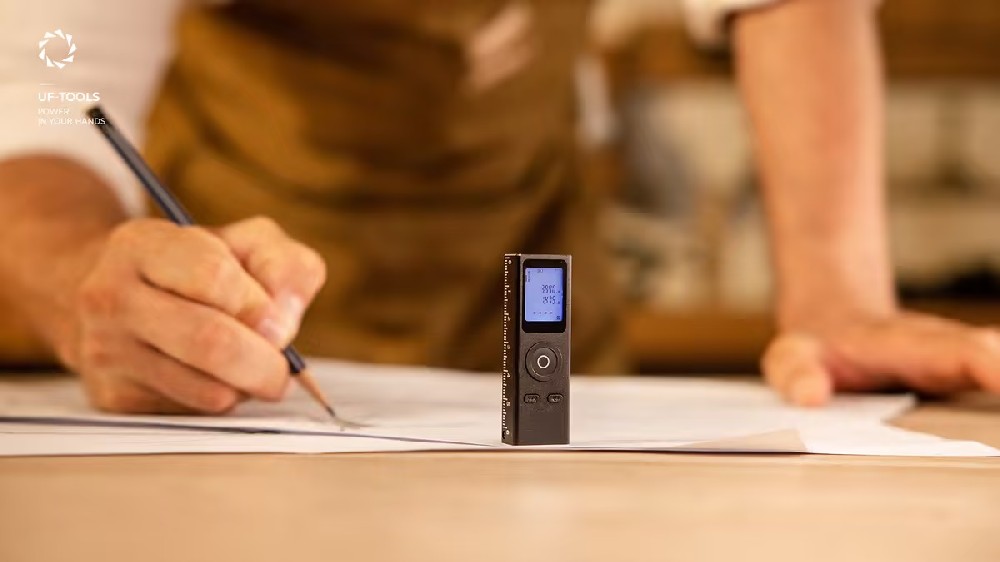Mini laser distance meters are precision measurement tools that use laser technology to provide fast and accurate distance measurements. With advancements in technology, these devices have found widespread applications in construction, interior design, landscaping, and more. UF-Tools specializes in producing high-quality mini laser distance meters, dedicated to providing reliable and user-friendly tools. This article will delve into the basic principles of mini laser distance meters, helping you better understand their working mechanisms and applications.
I. Basics of Laser Distance Measurement
A laser distance meter calculates distance by emitting a laser beam and measuring the time it takes for the reflection to return. The fundamental principle behind this is the constancy of the speed of light, which is approximately 299,792,458 meters per second. When a laser beam is emitted from the device, it reflects off a target object and returns to a receiver in the device. By measuring the time taken for this round trip, the device calculates the distance to the target object.
II. Pulse Method and Phase Method
Laser distance meters primarily use two techniques: the pulse method and the phase method.
1.Pulse Method
The pulse method involves measuring the time it takes for a laser pulse to travel to the target and back (time of flight). This method is suitable for long-distance measurements, commonly used in geographic surveying and construction.
2.Phase Method
The phase method measures the phase shift of a continuous wave laser to determine the distance. This technique offers high precision and is used in indoor measurements and applications requiring high accuracy. The core of the phase method is to use a modulated light source, where the laser signal has a specific phase, and after receiving the signal, the phase difference between the emitted and received signals can be converted into distance information.
III. Key Components of a Laser Distance Meter
The key components of a laser distance meter include a laser emitter, receiver, clock, and processing unit.
1.Laser Emitter
This emits the laser beam. Commonly used lasers are diode lasers, known for their small size and high efficiency.
2.Receiver
This receives the reflected laser beam. The receiver usually uses a photodiode to convert light signals into electrical signals.
3.Clock
A high-precision clock measures the time difference between the emission and reception of the laser beam.
4.Processing Unit
This unit processes the received signals and calculates the distance. Modern distance meters often have microprocessors capable of complex calculations and data processing.
IV. Factors Affecting Accuracy and Error
The accuracy of a laser distance meter can be influenced by various factors, including environmental conditions, the characteristics of the target object’s surface, and the performance of the device itself.
1.Environmental Conditions
Temperature, humidity, and atmospheric pressure can affect the propagation speed of the laser beam, thereby impacting measurement accuracy.
2.Target Object Surface Characteristics
The roughness, color, and reflectivity of the surface can significantly influence the reflection of the laser beam. For example, a smooth white surface reflects laser better, while a rough or dark surface may absorb more laser, leading to measurement errors.
3.Device Performance
The quality of the laser distance meter, the precision of the optical system, and the accuracy of the clock can all affect the accuracy of the measurements.
V. Advantages of UF-Tools in the Mini Laser Distance Meter Industry
As a company specializing in tool manufacturing, UF-Tools has significant advantages in the mini laser distance meter field. Our products combine high precision, durability, and convenience, making them widely applicable for both professional and personal use. We are committed to continuous innovation, providing users with smarter and more efficient measurement tools.
Conclusion
Mini laser distance meters use precise laser technology to provide users with efficient and accurate measurement tools. Understanding their basic principles and working mechanisms not only helps in choosing the right device but also allows users to better utilize these tools for various measurement tasks. UF-Tools is committed to providing high-quality laser distance meters, offering users a more convenient measurement experience.
References
1. “Laser Distance Measurement Technology and Applications”
2. “Comparison of Pulse and Phase Methods”
3. “Error Analysis in Laser Distance Meters”
Kingsdun is a precision screwdriver manufacturer, if you are looking for a Chinese screwdriver manufacturer, please contact us, we will give you the most sincere advice, thank you
